-
Small Dog Place Home
-
A to Z Breed List
-
Cavalier King Charles Spaniel
›
›
>
By Janice Jones |Last Updated 02, 28, 2020
Cavalier King Charles Spaniel Fanciers use words such lovable, sweet, gentle, playful, devoted to owner, lap warmers and bed companions to describe this little cutie who has grown in popularity over the last couple of decades.
The Cavalier is one of the most popular breeds in the UK and gaining in popularity in the US.
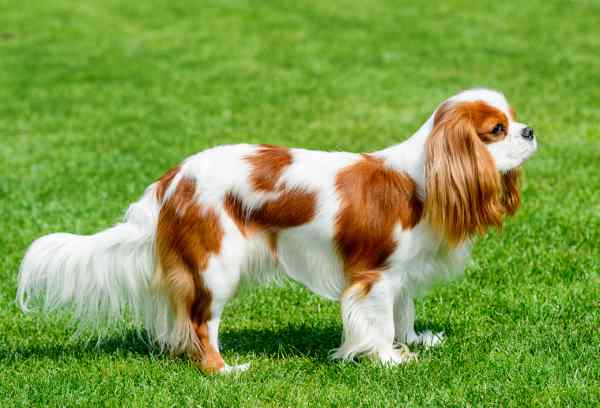
At 13 to 18 pounds and 12 to 13 inches in
height, it is among the largest of the toy breeds recognized by the American
Kennel Club, yet still small for being a spaniel.
These little guys are friendly, easy to
train, good with children and very adaptable to many different living
arrangements.
While new on the scene
with the AKC, becoming the 140th breed, the roots of the Cavalier
King Charles Spaniel goes back to the time of Charles II.
The most endearing characteristic of the Cavalier King Charles Spaniel is his face with dark soulful eyes.
They also have long, soft, silky hair which can be slightly wavy. The breed comes in four different colors: tricolor (‘Prince Charles’), red and white (‘Blenheim’), black and tan (‘King Charles’) and red (‘Ruby’).
Their devotion to their families makes them wonderful companions when their people are nearby. When left during the day or for long periods of time, these dogs do not do so well.
In general,
the Cavalier King Charles Spaniel is not a yappy breed and does not make a good
guard dog.
Their friendly nature assures
that any stranger entering the home is just another friend that they have yet
to meet. While mostly friendly, some can
be timid at times and stubborn.
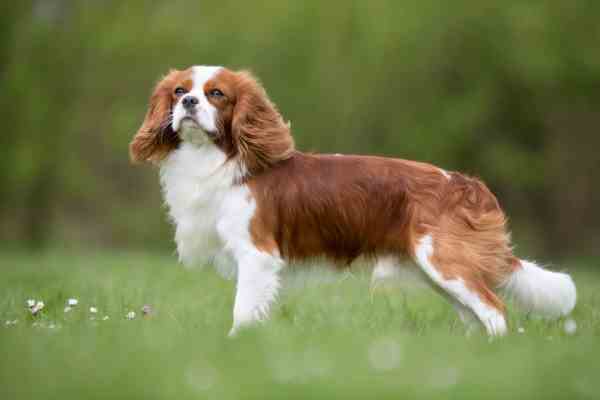 The Cavalier King Charles Spaniel
The Cavalier King Charles SpanielQuick Facts
Other Names
Used: Comforter Spaniel, foot warmer,
Cav, Cavalier, Cavie
Affiliation: AKC Toy, UK: Companion; ANKC, CKC, KC, NZKC, FCI
Size
Height: 12 to 13 inches (30–33 cm)
Weight: 13
to 18 pounds (5.9–8.2 kg)
Coat Type: moderately long, silky, wavy, but not curly
Colors: Four distinct color patterns
- Blenheim, a rich chestnut on a white
background. - Tricolor which is black markings
on a white coat with tan markings over the eyes, on the cheeks, and on the
underside of the tail (The American Kennel Club would refer to this as Black and with with tan markings) - Black and Tan, black with tan
markings over the eyes, on the cheeks, inside the ears, and on the chest,
legs and underside of the tail - Ruby, a solid rich reddish-brown
with no white spots or markings
Country of
Origin: England
Activity
Level: Moderately active
Life
Expectancy: 10-14 years
Good with
Children: Yes
Good with
other pets: Yes
| Traits | Rating |
|---|---|
| Playfulness | |
| Affection Level | |
| Friendliness Towards Strangers | |
| Good with Children | |
| Good with Other Dogs | |
| Good for First Time Owners | |
| Exercise Needed | |
| Ease of Training | |
| Watch Dog Ability | |
| Grooming Requirements | |
| Shedding | |
| Cold Tolerant | |
| Heat Tolerant |
Explanations for At a Glance Ratings
- Playfulness: Most=5 Less=1
- Affection: Most=5 Least=1
- Friendliness Towards Strangers: Most=5 Least=1
- Good with Children: Good=5 Not Good=1
- Good with Other Dogs: Good=5 Not Good=1
- Good for First Time Owners: Good=5 Not Good=1
- Amount of Exercise Required: Much=5 Minimal=1
- Ease of Training: Easy=5 Difficult=1
- Watch Dog Ability: Excellent=5 Poor=1
- Grooming Needs: Extensive=5 Minimal=1
- Shedding: Heavy Shedding=5 Minimal Shedding=1
- Cold Tolerance: Cold Well Tolerated=5 Poorly Tolerated=1
- Heat Tolerance: Heat Well Tolerated=5 Poorly Tolerated=1
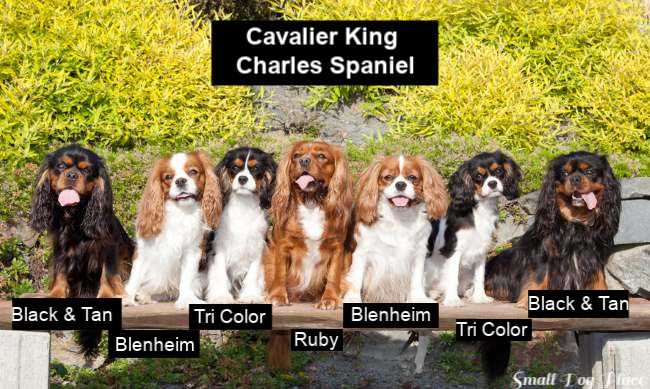
History of the Cavalier King Charles Spaniel
Little toy spaniels were very popular among royalty in the 16th through 18th centuries, serving as lap dogs and companions and even bedfellows to noble families in England.
It is these little dogs that have been depicted in famous paintings that are the forerunners of the modern day Cavalier King Charles spaniel.
Mary Queen of Scots had a little spaniel and King Charles II was said to have had at least two or three of these little dogs following him wherever he went.
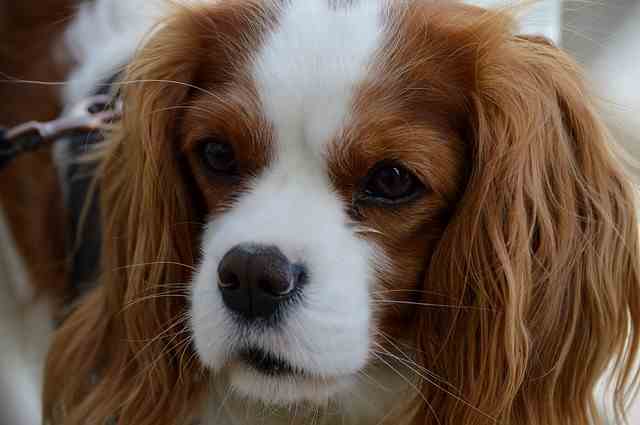
He went so far as to decree that
spaniels should be allowed in all public places including the Houses of Parliament.
The little spaniels remained popular until Charles II death when Pugs became
the new favorite.
It is said that the
spaniels were bred with the pugs to create a newer version of spaniel with
shorter noses and domed shaped heads.
The Benheim coloration that we know today
originated in Blenheim Palace, the country estate of the Dukes of Marlborough
where the strain of red and white toy spaniels continued to be bred.
It was
probably a rather haphazard breeding program as there were yet to be any
standards written or dog shows. It wasn’t
until the mid-19th century that dog shows became popular and English
breeders began to define the different breeds that we know today.
At that point in history, the toy spaniel was
described as having a flat face, undershot jaw, domed skull and large front
facing eyes. This is a far cry from the original
spaniel found in paintings from the 16th century.
In the 1920s, Roswell Eldridge, an American
began searching England for toy spaniels that resembled those in the old
paintings.
He urged the Kennel Club to allow him to offer 25 pounds sterling for
the best dog and best bitch resembling those seen in paintings of King Charles II’s reign.
Finally in 1928, Miss Mostyn Walker presented
a dog named Ann’s Son for evaluation and was awarded the 25-pound prize. Sadly,
Roswell Eldridge didn’t live to see the prize claimed, as he had died just one
month earlier.
That was all that was needed to get the momentum
rolling and soon a breed club was formed.
The name Cavalier King Charles Spaniel was chosen to differentiate it
from the flat faced King Charles spaniel, also known as the English toy spaniel
in the United States.
Standards were written and Ann’s Son was
considered an example of the breed. The
Kennel Club did not immediately recognize the new breed and it wasn’t until
1945 after years of work that it was finally recognized as a separate breed.
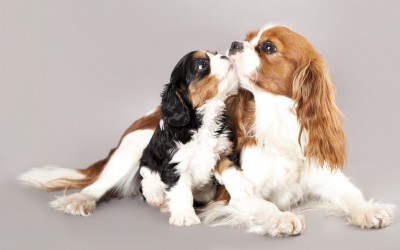
In the United States, the beginning of the
Cavalier dates back to the 1950s. Mrs,
Sally Lyons Brown of Kentucky was given a tan bitch puppy by her English friend
and then imported more.
She was unable
to register her dogs with the AKC, so she began the Cavalier King Charles
Spaniel Club in the USA. (CKCSC,
USA).
They did not push for full AKC recognition
because they feared that too much popularity would lead to breeders who wouldn’t
maintain the high standards they had established.
The AKC invited the CKCSC, USA to become the
parent club of the breed in 1992, but the members refused.
A small group of CKCSC, USA broke away and formed
the American Cavalier King Charles Spaniel Club (ACKCSC) and applied to the AKC
for parent-club status. AKC recognized this parent group and granted official recognition
of the breed in 1995.
Today, the CKCSC,
USA is still an independent breed registry, but the ACKCSC is the parent club
for the breed within the AKC.
Ideas for the Cavalier King Charles Spaniel Lover
The Cavalier King Charles Dog Breed at a Glance
Personality
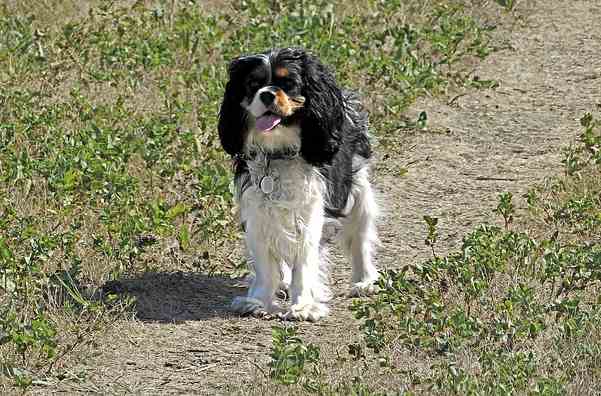
If affection
and devotion are your prerequisites for owning a dog, then this breed might be
perfect.
They are patient, eager to
please and highly adaptable. This makes
them a great choice for families with children and other dogs, because Cavalier King Charles Spaniels love both.
They are also popular among
seniors as their demands are low and love high.
While they have a playful nature and a curious temperament, they excel
as lap dogs making them good candidates for therapy work and elderly owners.
Don’t expect
them to be a good guard dog, because they are likely to love each and every one
that comes through your door. Even though
they may be one of the smallest spaniels, they are still true to this group of
dogs.
As such, they may chase anything
that runs in their path, including cars, so leash training is a must.
Training
As far as train-ability is concerned, Cavalier King Charles Spaniels are naturally well
behaved, and training is easy.
They do
well with positive reinforcement and a gentle approach. They do not do well with any harsh or
negative treatment.
They participate in
obedience and agility and excel as therapy dogs. These dogs do need to be socialized early
because of their natural tendency to be timid.
Without training this shyness can develop into phobias.
Grooming
Grooming the Cavalier King Charles Spaniel is relatively easy making it an ideal breed for those who do not see themselves spending hours providing a spa experience for their pooch. Even though the Cavalier’s coat is medium long, it is not clipped.
They are naturally clean dogs so a daily combing and a weekly bath, along with other regular grooming tasks may be all that is necessary to keeping them looking great.
The silky coat of the Cavalier is easy to keep clean and shiny using a firm-bristled brush and wide-toothed comb several times a week to keep tangles away. They do shed, though, so folks with allergies may want to consider a different breed.
Tooth brushing once a day and nail clipping are important for health or if you prefer, use a dremel tool to grind the nails. Dogs with ears that drop are prone to ear infections, so keeping the ears cleaned and dry is a must.
Before bathing, we recommend you take care of all other grooming tasks. To protect the ears during the bath, place a small cotton ball in each ear.
To be thoroughly complete, the grooming tool box of a Cavalier King Charles Spaniel owner should include a variety of items.
Bristle brush for daily brushing
slicker brush to help remove mats if present
Clipper with a number 10 blade,
Good quality protein shampoo and conditioner,
cotton swabs, ear cleaning solution,
eye wipes or cleaner,
Nail clippers or dremel and some styptic powder
Even though the list above seems like a lot of equipment, it will pay for itself within the first year if you choose not to get your dog groomed professionally.
The firm bristled brush is great for the daily brush out as long as there are no mats. If mats are present, use the slicker brush or side of the steel comb, combing gently to de-tangle and separate the mat.
A good quality ear cleaner preferably one prescribed by your veterinarian is used weekly to clean the ears. My favorite is mentioned below.
I originally purchased from my vet but then found it online and was able to save a little money.
Place a few drops in the ear, massage, and then clean out with the cotton balls. Use eye wipes or solution daily to remove any debris and tears around the eyes.
The clipper and Number 10 blade is used to shave a small area around the anus, groin and partially down the inside of the back legs. Called a sanitary clip, this keeps the dog cleaner between baths.
The clippers can also be used to remove hair between the foot pads or if the dog will not tolerate this, use the shears to carefully remove any hair between the pads that grows longer than the actual pad.
Once these tasks have been completed, you can bathe the dog with protein shampoo and finish with a conditioning rinse. Use a hair dryer and brush to achieve the smoothest finish.
Finally, use the slicker brush for the final brush out. If the dog has some stray hairs, use the shears to trim them off. Whiskers can be trimmed if desired.
Health
The Cavalier King Charles Spaniel is a relatively healthy breed but there are some diseases that tend to occur in the breed. The parent club has worked hard to educate breeders on the various genetic tests that can be done on the parents to assure healthy puppies.
Please do not get frightened by the list as it is highly likely that your puppy will never suffer from any of these conditions.
Pros
- Friendly,
gentle, affectionate - Gets along
well with children and other animals - Relatively
healthy breed but does have some problems - Relatively
easy to groom
Cons
- Sheds
- Not good as
a guard dog - Crave
attention and don’t do well if left along for long periods of time - Needs
socialization to prevent them from being too timid
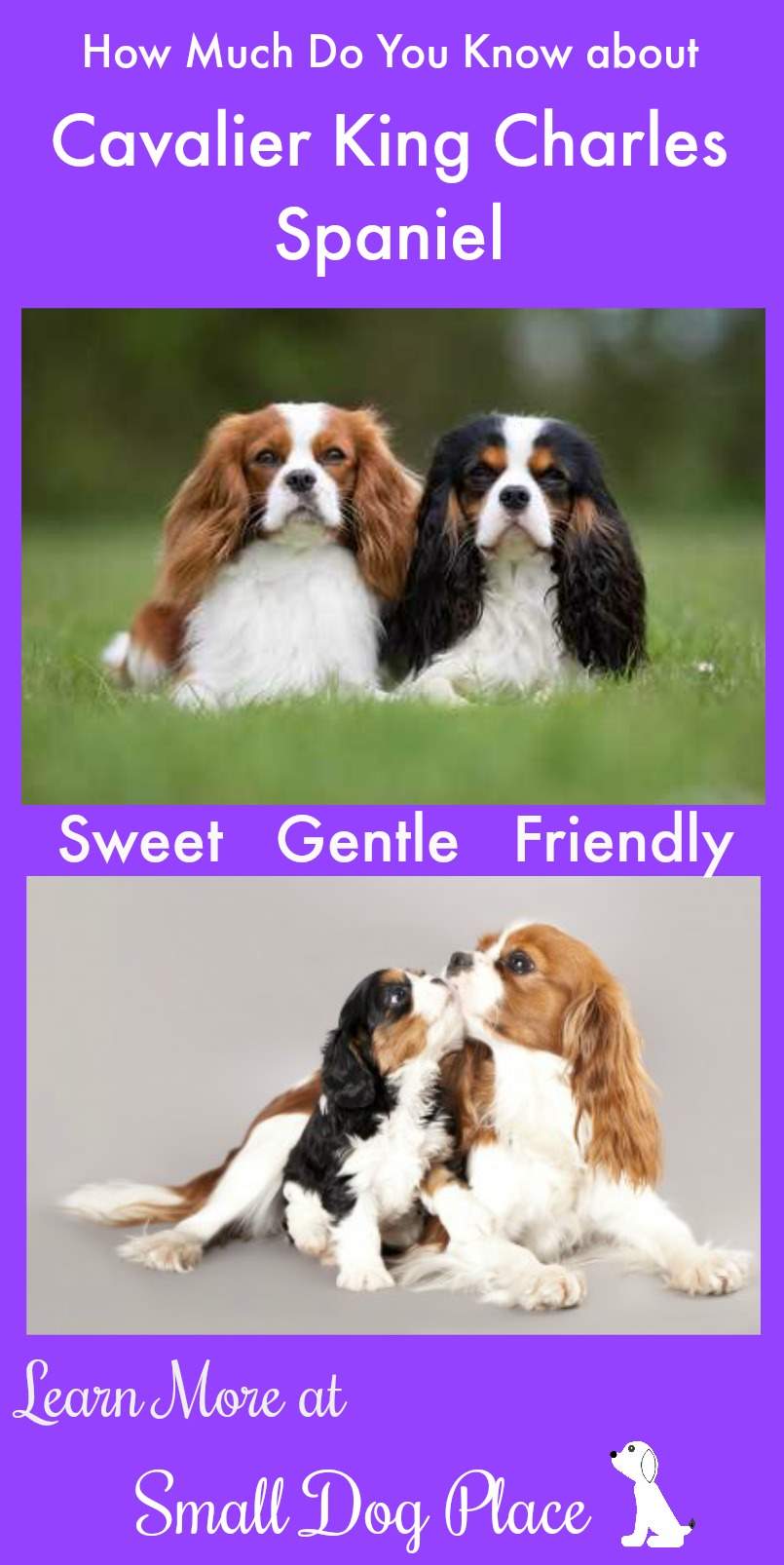 Cavalier King Charles Spaniel Breed Profile
Cavalier King Charles Spaniel Breed ProfileReferences/Resources
Breed Club
Cavalier
King Charles Spaniel Club, USA
American
Cavalier King Charles Spaniel Club, Inc.
Rescue
ACKCS
Rescue Trust, Inc.
Does This Article Deserve Your Thumbs Up?
We always appreciate your support and encouragement. Your thumbs up means so much to us. Please like this article.
If you find this page or any page on Small Dog Place Helpful, or Useful in anyway, I’d love it if you would click the small heart found on the bottom right of each page.
You can also share or bookmark this page — just click on the:

Free Monthly Newsletter
Sign Up for Our Free Newsletter and get our Free Gift to You.
my E-book, The Top 10 Mistakes People Make When Choosing a Dog (and how to avoid them)
If you enjoyed this page, I’d love it if you’d let me know. Just click the button below. Thank you.
Sharing is Caring


